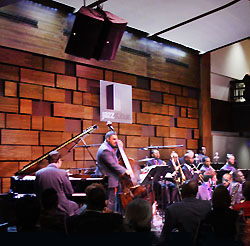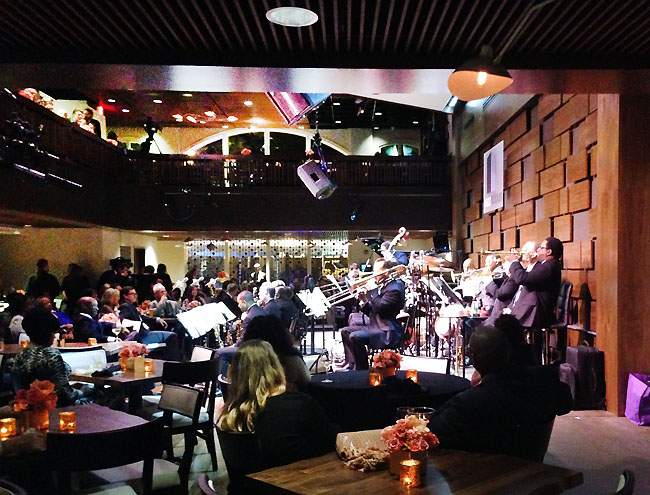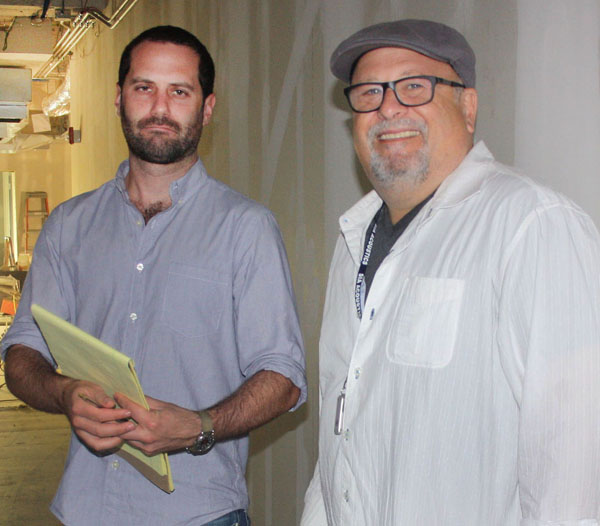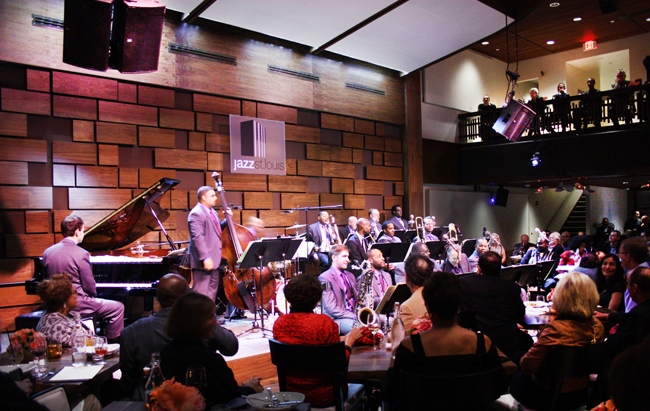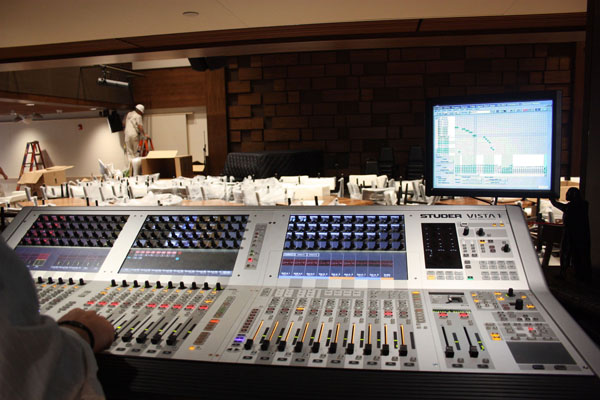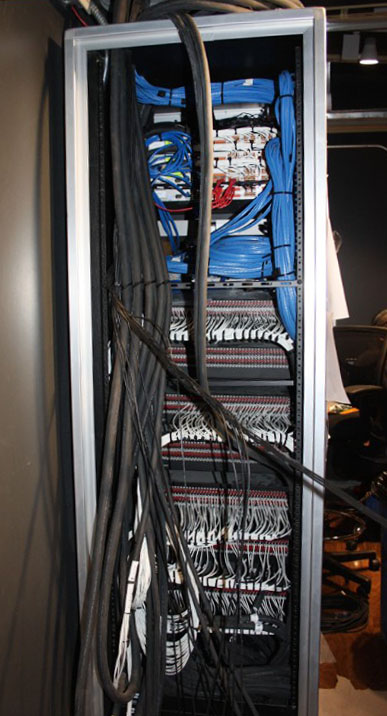Twenty years ago, Jazz at the Bistro launched in a former cafeteria in midtown St. Louis, and since then has been lauded by many as one of the premiere live jazz spots in the U.S. The venue is operated by Jazz St. Louis, a not-for-profit organization established after the closing of the Just Jazz program at the Hotel Majestic.
The Jazz St. Louis mandate is straightforward: “Present jazz the way it’s meant to be experienced.” In service of that mandate, the venue has undergone a complete transformation spearheaded by executive director Gene Dobbs Bradford and World Wide Technology founder Dave Steward.
Named for Steward’s parents, the new Harold and Dorothy Steward Center for Jazz has expanded into an adjacent building. Audience capacity for the main performance space, which is called The Ferring Jazz Bistro, has increased from 150 to 220. Additional facilities include the new Centene Jazz Education Center and a separate, 75-capacity jazz lounge that can also host performances in addition to serving as a place to remotely view a video feed of performances happening in the bistro.
Promoting Interaction
The physical layout of the bistro has been completely reconfigured. The stage was relocated from the south wall of the venue to its wider east wall to increase the intimacy of the venue by allowing more people to sit close to the stage, and the balcony was opened up for additional seating.
The intent, explains Sam Berkow, founding partner of SIA Acoustics (New York & Los Angeles), who designed the sound system and acoustic treatments for the facility, was to provide a stage environment that promoted interaction between both the players on stage and the audience. An important goal of the stage design creating an acoustical environment enabling them to hear and react organically to each other.
Berkow worked closely with SIA senior consultant Jeffrey Friedlander as well as with the project’s architects, engineers and designers to ensure the result of a significantly improved live music experience. Logic Systems Sound & Lighting, a leading integrator based in nearby Valley Park, MO, made these plans a reality by providing the installation as well as custom engineering work.
“What we did immediately upon getting involved was to understand the program,” Berkow explains. “We looked at the range of musical styles, from solo artists to big band, from lightly to heavily amplified, and what became clear to us is that people wanted to hear the music off the stage. So the audio system couldn’t be the primary source of sound. For most shows, the stage had to be a significant source of sound.”
SIA helped create a space where the musicians can hear each other through acoustical reinforcement provided by a wall behind the stage and a canopy above, both equipped with sound scattering surfaces similar to a sound diffusing wall in a recording studio. “We eliminated all of the strong reflections coming off the upstage wall and the ceiling,” Berkow adds. “For a traditional orchestra you sometimes want those reflections, so for example, the cellos can hear the oboes, but in a jazz ensemble you have much more power in a much smaller area, so diffusion is a better choice.”
The canopy contains 10 acoustical diffusive elements and is covered with an acoustically transparent fabric to provide an aesthetically pleasing look. It also serves as the support structure for the flown portion of the house loudspeaker system.
“We were trying to create a stage that was comfortable for musicians and projected into the audience with a canopy that would reflect energy out, without strong reflections creating uneven spots in the audience,” he continues. “The canopy itself is made of wood and the acoustical panels were created by Real Acoustix, and these helped in creating a live sounding room without hard reflections.”
Additional acoustic treatments were applied to the ceilings throughout the venue, and background noise from the new HVAC system was minimized with extra lining throughout and in-line duct silencers for sound-critical walls. “In a jazz venue, when the band gets quiet you really hear background noise,” Berkow observes.
Character And Quality
Several options were considered for house system loudspeakers, but ultimately Berkow went with VUE Audiotechnik models to provide appropriately subtle sound reinforcement. Specifically, the design incorporates two VUE h-12N 2-way, single 12-inch active loudspeakers per side, each pair flown together left and right about 14 feet above the stage. The loudspeakers offer 60- x 40-degree (h x v) coverage combined with integrated amplification, DSP and network/control capability.

“A primary reason we selected these loudspeakers is their use of new technology for the high-frequency driver, which features both a neodymium compression driver with a 4-inch voice coil and a Truextent beryllium diaphragm,” Berkow states. “The result is lower distortion and more efficiency, which means, for the listener, the sound of the system will closely match the stage sound and allow the nuance and tone of acoustic instruments to be heard clearly.”
Two VUE hs-20 dual 10-inch subwoofers are integrated within the stage, one per side. “We cut the corners of the stage out, and the subs come up about 4 inches above that,” Berkow says. “I like to keep the subwoofers on the ground if possible. When low frequencies come from above, it feels like the image moves up.”
Eight VUE h-8 compact 2-way loudspeakers provide fill on delay, mounted in a “U” configuration that follows the contour of the stage. “There’s one h-8 per side mounted on the upstage wall, just under where the balcony wraps around the stage, serve the main floor,” adds Chip Self, vice president of Cignal Systems. “The other six are flown above the dance floor and serve the balcony.”
Overall, the selection of the VUE loudspeakers came down to a strict requirement not to alter the true sonic character of the instruments. “Tone and nuance, the individual characteristics of specific instruments, really matter to jazz fans,” Berkow notes. “The even, smooth coverage and very low distortion of the drivers in these loudspeakers allow the character and tonal quality of each instrument to be amplified without coloration. A bonus is that we were seeking a self-powered solution to help save rack space.”
Aesthetics were also a concern, he adds. “People don’t want to be looking at a giant sound system, but we wanted to ensure there’s enough PA that when they bring in bands that are more fusion or rock oriented they can rock the room.”
Additional Elements
A Studer Vista 1 is the new system’s digital console, housed in a booth roughly 40 feet from the stage that also houses rack-mounted BSS Soundweb London processors that provide main system management. Although the booth is a discreet room, it’s acoustically treated to match the performance area, fronted by a 10- x 4-foot (w x h) opening.
The Vista 1 was chosen by Bob Bennett, the venue’s artistic director and director of operations, who notes, “The Vista 1 was most natural sounding board I’ve heard. It’s also the first digital console I’ve used, but it’s extremely easy to work with.”
Most of the time, monitors are also mixed via the Vista 1, which can provide up to 10 mono and four stereo mixes to up to six Fulcrum Acoustic FA28ac self-powered coaxial wedges. If necessary, Bennett can also deploy the pre-existing Midas Venice analog console from the previous system for monitors.
Only a few elements were added to the existing microphone package, notably a pair of Schoeps MK4 cardioid mics that Bennett uses in conjunction with an AKG 414 condenser for the venue’s 7-foot Yamaha grand piano. “I place the 414 on the low end of the piano, about halfway back on the soundboard, with the two Schoeps mics closer to the hammers,” he explains.
Although some mics are typically deployed during performances, most are only used in the lounge. “I like to use as few mics as possible, because the more open mics on stage, the crazier it’s going to be,” Bennett notes. Kick drum is handled with a Shure BETA 52 and Electro-Voice RE20s for overheads. When there’s need for a snare mic, it’s a Shure SM57, and horns can be captured individually with RE20s. For true big bands, the choice is two C 414s across the horn sections.
A Shure BETA 58 and Neumann KMS 105 are available for vocalists, and guitars are captured with either SM57s or SM58s. “For bass, if miking the F hole, I’ll use an RE20, but for electric bass usually the choice is a BSS AR-133 DI or taking the line out from the amp, joined by an acoustic mic, depending on the player,” he says, adding that he uses AR-133s exclusively for bass, keyboards and electro-acoustic instruments. “But again, what’s miked is mostly going to the lounge. In the house system there may be no drums. We’re heavy on keys and vocals – light on horns, bass and guitar – depending on the band and stage volume.”
“It’s very much an enhancement system,” Self adds. “It would be unusual to have a full mix in the mains because the acoustics of the room are so good that very few instruments need to be amplified.”
Future Considerations
SIA also provided the design for the electronic and architectural infrastructure for the third floor’s educational facility, which includes a full recording studio, a large live/rehearsal room and various practice rooms and teaching spaces. All of the rooms are interconnected so performances in any room or combination of rooms, including the bistro, can be recorded in stereo and/or 48-channel multitrack as well as HD video. Logic Systems did the hard work of putting all of this together.
“There’s an inordinate amount of copper for a space this size,” Self notes. “I asked early in the project, ‘Why don’t we do this digitally?’ But Sam was directed to create an infrastructure that was going to last; you never know what digital transport method or format is going to be in use 10 or 20 years from now, but an XLR is still going to be an XLR. So essentially we future-proofed by using older technology.”
All who worked on the project agree that a significant challenge was the timeline; the venue closed in May 2014 and needed to be ready to reopen by October for previously booked events, including a show by Wynton Marsalis.
“The timeline was absolutely insane, but the folks working with us did an incredible job,” Bennett concludes. “We had to evaluate a variety of consoles and loudspeakers in the old room to figure out what would work best for the new space, and went from there. This room was never intended to be a live venue, so when we first started booking shows it was acoustic music – nothing electric. The previous system worked fine for that, but as our programming evolved, our needs changed, and this new room design and system will serve us very well into the future.”
Based in Toronto, Kevin Young is a freelance music and tech writer, professional musician and composer.

